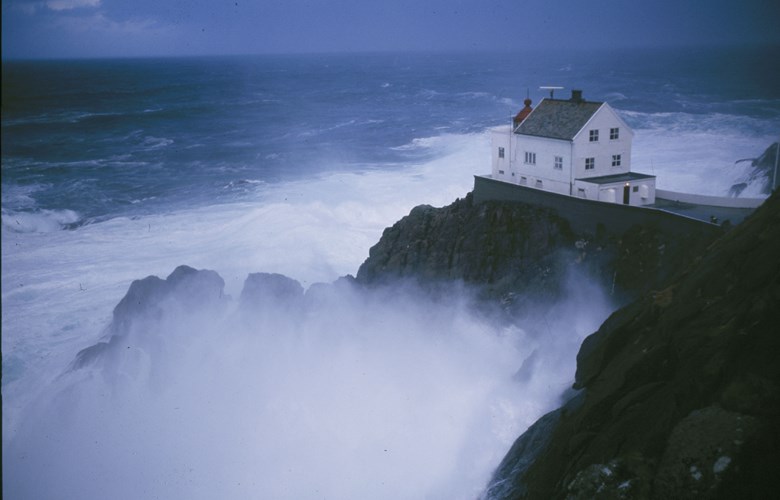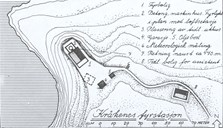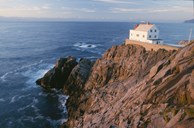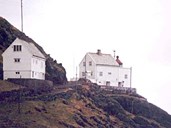Pressure from the Kristiansund Skipper Association
In 1892, the Kristiansund Skipper Association had pointed out the need for a lighthouse on the northern side of the island of Vågsøya. In 1904, this request was once more underlined, and a sum of 42 000 kroner was set aside for the project. This sum was spent to construct a wooden building, measuring 9.7 by 8.2 metres. The beacon itself was placed on the same level as the ground floor of the station. An outbuilding was also raised, containing an office, a storage room and a woodshed. The beacon was lit on 1 October, 1906. The Kråkenes lighthouse functions above all as a guiding light into the waters of Sildegapet to the south of Stadlandet.
Family residence
The Kråkenes lighthouse station was planned to be operated by a family - the lighthouse keeper with wife and children. Up until 1911, the keeper's two adult sons lived at home and they helped operate the lighthouse. When they left home, an assistant was employed. In the 1930s, a separate house for the assistant was built about 70 metres east of the lighthouse.
The nearest shop was Raudeberg, seven kilometres by sea. It was also possible to get there on land, but it was heavy going, and it took three hours each way. To the primary school at the Kråkenes farms the road distance was two kilometres.
It was far from easy to get to and fro the lighthouse by boat. The boat-landing conditions were very difficult. When they got to the lighthouse by boat, the boat had to be hoisted up by means of a swing crane standing on a high platform. Then the boat had to be hauled up on rails into the boathouse. The landing site was about 500 metres from the station.
World War II
During the war German forces took over the lighthouse station. There could be up to 100 troops stationed there to man the cannon positions and operate the bearing instruments. The Germans also started to build a jetty, but this was destroyed by heavy seas. They also had plans to build stronger fortifications with heavier guns, but nothing came out of it. In 1944, allied forces attacked the lighthouse station and destroyed the beacon.
The assistant, who happened to be in the lighthouse when it was attacked, barely escaped. In March, 1945, there was another attack. The oil tanks exploded and the whole station burned to the ground. Fortunately, nobody was inside the station. A temporary beacon was installed in front of the station in 1946. About 1950, the whole station had been rebuilt.
The people in the hamlet of Kråkenesbygda lived under miserable conditions during the war. About 60 German troops were stationed at the two farms. The farms were fenced in by a belt of 2000 land mines, and people actually needed passes in order to work in their own hayfields. The German also had a major radar installation in the vicinity. There are still remnants of the foundation walls.
Automation in 1986
In 1933, work was started on building a road across the mountains to the hamlet of Kråkenes. This work was completed by the Germans. In 1961, the lighthouse station was connected to the local electricity grid, which meant the end of 55 years of a diesel generator. The generator is still kept in reserve in case of a power outage.
Up until 1983, the Kråkenes was still a "family lighthouse". In that year the lighthouse became a so-called turn station with lighthouse keepers working in shifts. In 1986, the lighthouse became fully automated, and there have been no keepers stationed there since 1993. A man from the hamlet of Kråkenesbygda has looked after the station buildings in recent years.
Tourism
The road completed by the Germans was since improved so that it was possible to drive all the way to the lighthouse station. The lighthouse gradually became a popular tourist attraction. The local council took over the buildings which were then let for a term of years.
In the late 1990s, the German couple Thomas Bickhardt and Bettina Vick became hosts at the lighthouse station. They live there throughout the summer season and take care of the maintenance of the buildings. Most of the guests come from Germany, either in groups or as individual tourists. The station can accommodate 12-13 visitors in the two houses. The distance from the lighthouse to Kråkenesbygda is two kilometres. The hamlet now has 30 permanent residents, but previously up to 100 persons lived there.




